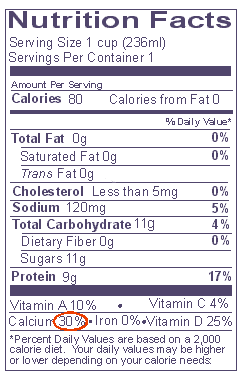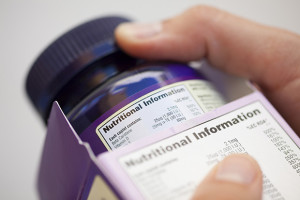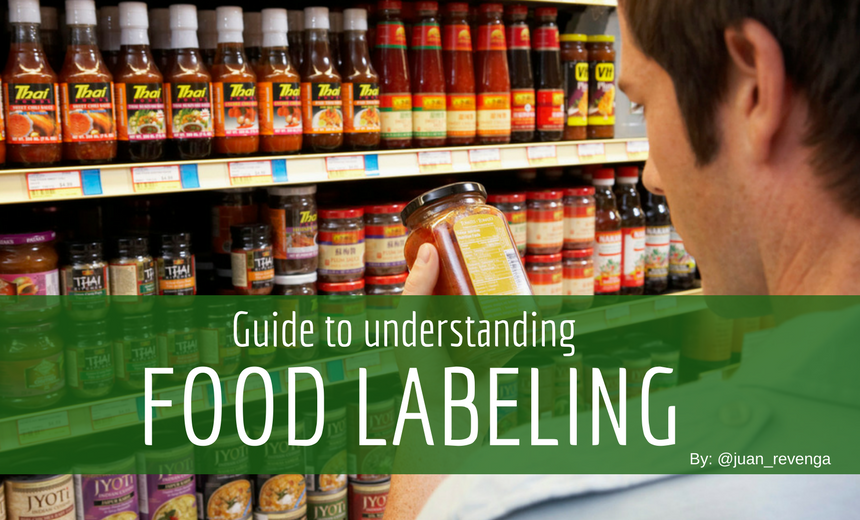Guide to understanding food labeling
Food labeling becomes a true jumble of ingredients, calories, grams, percentages and other data difficult to interpret. This post will provide you with tools to clarify its meaning.
Nothing worse than having information and have no idea of how to understand it. In fact, it can drive us to a biggest mistake: to be sure about something while being wrong at the same time. And making decisions under a wrong certainty.
 In its origin food labeling should serve consumers to make better decisions regarding themselves interest. However, general population is under a huge nutritional jumble, same information is crystal clear for some while confusing others. Legislator´s will is the one to put order and fix nutritional information giving all the information that may affect our food election, whichever it is the motivation.
In its origin food labeling should serve consumers to make better decisions regarding themselves interest. However, general population is under a huge nutritional jumble, same information is crystal clear for some while confusing others. Legislator´s will is the one to put order and fix nutritional information giving all the information that may affect our food election, whichever it is the motivation.
As a matter of fact, the present European rule for this issues (Regulation (EU) No 1169/2011 of the European Parliament and of the Council of 25 October 2011 on the provision of food information to consumers) stands that : “The provision of food information shall pursue a high level of protection of consumers’ health and interests by providing a basis for final consumers to make informed choices and to make safe use of food, with particular regard to health, economic, environmental, social and ethical considerations.”
So, let see which are the suitable matters that food labeling shall show up.
Mandatory information
- Information on the identity and composition, properties or other characteristics of the food
- Information on the protection of consumers’ health and the safe use of a food, such as allergens, durability, storage and safe use
- Information on nutritional characteristics to enable consumers, including those with special dietary requirements, to make informed choices.

Packaged products
Nevertheless, what makes mandatory to give specific labeling information relays basically in one question: whether it is packaged or not. So, the following information is mandatory for packaged products:
- Name of the food: shall be its legal name. In the absence of such a name, the name of the food shall be its customary name, or, if there is no customary name or the customary name is not used, a descriptive name of the food shall be provided.
- List of ingredients: It shall include all the ingredients of the food, in descending order of weight, as recorded at the time of their use in the manufacture of the food. The following foods shall not be required to bear a list of ingredients: fresh fruit and vegetables, including potatoes, which have not been peeled, cut or similarly treated. fermentation vinegars derived exclusively from a single basic product, provided that no other ingredient has been added.
- Products causing allergies or intolerances: the labelling shall make it clear for each ingredient or processing aid concerned.
- Net quantity: The net quantity of a food shall be expressed using liters, centiliters, milliliters, kilograms or grams, as appropriate.
- Minimum durability date, ‘use by’ date and date of freezing: In the case of foods which, from a microbiological point of view, are highly perishable and are therefore likely after a brief period to constitute an immediate danger to human health, the date of minimum durability shall be replaced by the ‘use by’ date. After the ‘use by’ date a food shall be deemed to be unsafe.
- Storage conditions or conditions of use: In cases where foods require special storage conditions and/or conditions of use, those conditions shall be indicated.
- Company: legal name of the company and address
- Country of origin or place of provenance: It is mandatory to provide information on the country of origin or place of origin (RE 1337/2013) in packaged meat of certain species (sheep, pigs, goats and poultry).
- Instructions for use: The instructions for use of a food shall be indicated in such a way as to enable appropriate use to be made of the food.
- Alcoholic strength: The actual alcoholic strength by volume of beverages containing more than 1,2 % by volume of alcohol
- Nutritional information: will include the energy value and amounts of fats, saturated fats, carbohydrates, sugars, proteins and salt.
Non-packeged foods
 Non-packaged foods, that is, those supplied in establishments that serve meals (bars, restaurants, canteens, etc.), which are supplied to other establishments (nursing homes, hospitals, schools, etc.), that are sold by weight or in bulk (vegetables, vegetables, etc.), products that are packaged at the request of the consumer (cold meats, fish, etc.), or are packaged by the holders of the retail trade for immediate sale in the establishment or establishments of their property; Have to include mandatory information different from the packaged products, and can use labels, posters or any other means, including modern technological tools, and, importantly, verbal communication. In any case, such mandatory information must include, without a doubt, the presence of substances that cause allergies or intolerances. In addition, and in each of the different considered cases:
Non-packaged foods, that is, those supplied in establishments that serve meals (bars, restaurants, canteens, etc.), which are supplied to other establishments (nursing homes, hospitals, schools, etc.), that are sold by weight or in bulk (vegetables, vegetables, etc.), products that are packaged at the request of the consumer (cold meats, fish, etc.), or are packaged by the holders of the retail trade for immediate sale in the establishment or establishments of their property; Have to include mandatory information different from the packaged products, and can use labels, posters or any other means, including modern technological tools, and, importantly, verbal communication. In any case, such mandatory information must include, without a doubt, the presence of substances that cause allergies or intolerances. In addition, and in each of the different considered cases:
- Non-packaged food supplied by communities: restaurants, canteens, hospitals … the mandatory information is related to the ingredients susceptible to cause food allergies or intolerances.
- Unpackaged or packaged foods at the point of sale at the request of the buyer: must inform the name of the food, quantity of ingredients and alcoholic strength in beverages with a graduation of more than 1.2%. In some cases, it may be mandatory to provide other data.
- Food packaged by retailers for immediate sale: must carry the same information as packaged products, except for nutritional information, that is the name of the food, ingredients, substances causing allergies and intolerances, net quantity, country of origin, and in some circumstances, date of preferential consumption or expiration date, special storage conditions, operator data …
- Food packaged in bags: in the case of fruits, vegetables, tubers or nuts packed in bags or with containers that allow a clear appreciation of the food with the naked eye, they must report only the name of the food, net quantity and food company.
A separate mention deserves the question of the information offered to the consumer in food purchased “at a distance”, many times through the internet. In these cases, the mandatory information must always be identifiable according to each modality (except the country of origin, or place of origin) and be available before the purchase is completed without additional costs. All information will accompany the food at the time of delivery. Allergen information must always be provided prior to the purchase, and will accompany the food in writing at the time of delivery.
Nutritional information
 This is one of the most controversial and confusing issues. Something that is important since these are the questions driving to customer decision of buying. Let see it:
This is one of the most controversial and confusing issues. Something that is important since these are the questions driving to customer decision of buying. Let see it:
In summary, the nutritional information of a food refers to its energy value and to the presence of certain nutrients, namely: fats, saturated fats, carbohydrates, sugars, proteins, salt and certain vitamins and minerals.
- Mandatory nutritional information must include, at least and in this order, the energy value (expressed in kilojoules -kJ- and kilocalories -kcal-) and the amounts of fats, saturated fats, carbohydrates, sugars, proteins and salt.
- It may also be supplemented by an indication of the amount of one or more of the following substances: monounsaturated fats, polyunsaturated fats, polyalcohol, starch, dietary fiber, vitamins and minerals (when present in significant amounts.
In any case, unprocessed or cured products based on a single ingredient, water, salt, spices, tea, vinegars, food additives, beverages with an alcoholic strength by volume greater than 1.2%, food in containers whose surface area is less than 25 cm2 (such as jams or catering butters), among others. Non-packaged foods are also exempt, but may be given voluntarily by limiting to the energy value, or to the energy value and amount of fats, saturated fats, sugars and salt, and expressed only by portions or consumption units.
In summary
As we have begun saying and reflecting the current standard on labeling, it is not easy to address in a single post all the nuances inherent in this issue. Beyond the list of ingredients and nutritional information, issues of allergens or substances liable to cause intolerance, health claims, how to include all the information (package location, letter size, Etc.) are matters that generate a wide debate among the professionals involved.
In any case, if a healthy eating pattern is to be built, I am increasingly convinced that focusing on the purchase of unlabeled, mostly fresh food is one of the simplest recommendations. I am not saying that labeling is pernicious per se … but yes, most of the foods that are unlabeled and distributed without labels (for example, market food) are probably healthier.
By Juan Revenga, dietician-nutritionist
Latest posts by Juan Revenga Frauca (see all)
- Obesity recognized as a chronic disease - 13 October, 2021
- Who said you have to eat everything? - 7 October, 2021
- Diabetes and Alzheimer - 29 January, 2021








